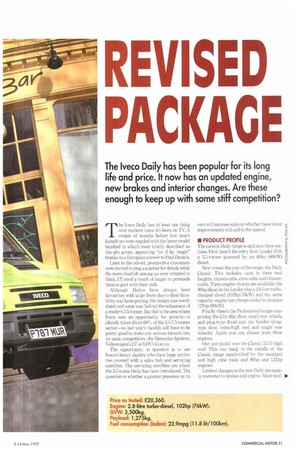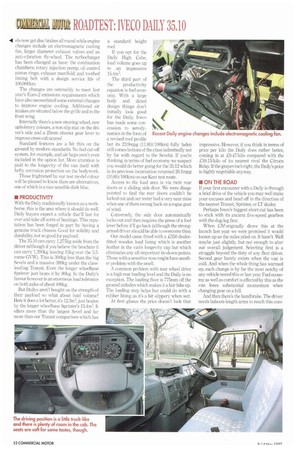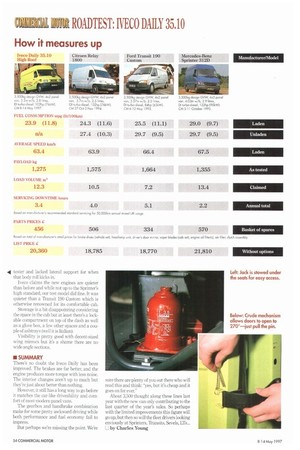The Iveco Daily has been popular for its long life
Page 53

Page 54

Page 55

Page 56

If you've noticed an error in this article please click here to report it so we can fix it.
and price. It now has an updated engine, new brakes and interior changes. Are these enough to keep up with some stiff competition?
The (yew Daily has at least one thing over modern vans: it's been on TV. A couple of months before last year's launch we were regaled with the latest model finished in what's most kindly described as day-glo green, appearing "as if by magic" thanks to a European answer to Paul Daniels.
Later in the advert, prospective customers were invited to ring a number for details while the more churlish among us were tempted to think it'll need a touch of magic to persuade them to part with their cash.
Although Dailys have always been favourites with large fleets due to their durability and keen pricing, the design was sorely dated and some way behind the refinement of a modern 3.5-tonner. But this is the area where Iveco sees an opportunity for growth—it already takes about 60% of the 3.5-7.5 tonnes sector—so last year's facelift will have to be pretty good to make any serious inroads into its main competitors, the Mercedes Sprinter, Volkswagen's LT or LDV's Convoy.
The opportunity in question is to use lveco's heavy dealers who have large territories covered with a sales hub and servicing satellites. The servicing satellites are where the 3.5-tonne Daily has been introduced. The question is whether a greater presence on its own will increase sales or whether these latest improvements will add to the appeal.
NI PRODUCT PROFILE The current Daily range is split into three sections. First there's the entry level Leader 35.8; a 3.5-tonner powered by an 80hp (60kW) diesel.
Next comes the core of the range, the Daily Classic. This includes vans in three roof heights, chassis-cabs, crew-cabs and chassiscowls. Three engine choices are available: the 80hp diesel in the Leader plus a 2.8-litre turbocharged diesel (102hp176kW) and the same capacity engine but charge-cooled to produce 121hp (90kW).
Finally there's the Professional range comprising the City (flat floor, small rear wheels and plug-type door) and the Vendor (plugtype door, extra-high roof and single rear wheels). Again you can choose from three engines.
Our test model was the Classic 35.10 high roof. This sits bang in the middle of the Classic range sandwiched by the standard and high cube roofs and 80hp and 121hp engines.
Limited changes to the new Daily are mainly restricted to brakes and engine. Most mod110. els now get disc brakes all round while engine changes include an electromagnetic cooling fan, larger diameter exhaust valves and an anti-vibration fly-wheel. The turbocharger has been changed as have: the combustion chambers; rotary injection pump; oil control piston rings; exhaust manifold; and toothed timing belt with a design service life of 100.000km.
The changes are ostensibly to meet last year's Euro-2 emissions requirements which have also necessitated some external changes to improve engine cooling. Additional air intakes are situated below the grille and in the front wing.
Internally there's a new steering wheel, new upholstery colours, a non-slip mat on the driver's side and a 25mm shorter gear lever to improve cross-cab access!
Standard features are a bit thin on the ground by modern standards. No fuel cut-off system, for example, and air bags aren't even included in the option list. More attention is paid to the longevity of the van itself with hefty corrosion protection on the bodywork.
Those frightened by our test model colour will be pleased to know there are alternatives, one of which is a nice sensible dark blue.
• PRODUCTIvrry With the Daily traditionally known as a workhorse. this is the area where it should do well. Daily buyers expect a vehicle that'll last for ever and take all sorts of beatings. This reputation has been forged in part by having a genuine truck chassis. Good for solidity and durability not so good for payload.
The 35.10 can carry 1,275kg aside from the driver (although if you believe the brochure it can carry 1.290kg leaving 15kg over the 3.5tonne GVW), This is 300kg less than the big Sevels and a massive 389kg under the classleading Transit. Even the longer wheelbase Sprinter just beats it by 80kg. in the Daily's favour however is an enormous load tolerance on both axles of about 400kg.
But Dailys aren't bought on the strength of their payload so what about load volume? Here it does a lot better, it's 12.3m3, just beaten by the longer wheelbase Sprinter's 13.4m3. It offers more than the largest Sevel and far more than our Transit comparison which has
a standard height roof.
If you opt for the Daily High Cube, load volume goes up to an impressive 15.4m3.
The third part of the productivity equation is fuel economy. With a large body and dated design things don't initially look good for the Daily. Iveco has made some concession to aerodynamics in the form of a revised roof profile but its 23.9mpg (11.81it/100km) fully laden still comes bottom of the class (admittedly not by far with regard to the Sevels). If you're thinking in terms of fuel economy we suspect you would do better going for the 35.12 which in its previous incarnation returned 26.1mpg (10.81it/100km) on our Kent test route.
Access to the load area is via twin rear doors or a sliding side door. We were disappointed to find the rear doors couldn't be locked out and our tester had a very near miss when one of them swung back on a rogue gust of wind.
Conversely the side door automatically locks out and then requires the press of a foot lever before it'll go back (although the strongarmed driver should be able to overcome this).
Our model came fitted with a £350 dealerfitted wooden load lining which is another feather in the van's longevity cap but which eliminates any all-important tie-down points. Those with a sensitive nose might have another problem with the smell.
A common problem with rear wheel drive is a high rear loading level and the Daily is no exception. The loading floor is 775mm off the ground unladen which makes it a fair hike up. The loading step helps but could do with a rubber lining as it's a bit slippery when wet.
At first glance the price doesn't look that impressive. However, if you think in terms of price per kilo the Daily does rather better, coming in at .€9.47/kilo compared with the L10.15/kilo of its nearest rival the Citroen Relay. If the grapevine's right, the Daily's price is highly negotiable anyway • ON THE ROAD If your first encounter with a Daily is through a brief drive of the vehicle you may well make your excuses and head off in the direction of the nearest Transit, Sprinter, or LT dealer.
Perhaps Iveco's biggest short-cut has been to stick with its ancient five-speed gearbox with the dog-leg first.
When CM originally drove this at the launch last year we were promised it would loosen up as the miles piled on. It hasn't. Well maybe just slightly, but not enough to alter our overall judgement. Selecting first is a struggle beyond the duty of any fleet driver. Second gear barely exists when the van is cold. And when the whole thing has warmed up, each change is by far the most notchy of any vehicle tested this or last year. Fuel economy as well as comfort is affected by this as the van loses substantial momentum when changing gear on a hill.
And then there's the handbrake. The driver needs baboon-length arms to reach this corn for tably. You frequently find it's still on after pulling away from a hill start and we suspect most drivers will eventually rely on the clutch for inclined starts.
But it's not all bad news. The new disc brakes work very well. In a group comparison they outperformed (subjectively at least) those of the Sprinter, Transit and Fiat Ducato. There is an amount of pedal travel but the portion that counts as play is light so it's easy to get accustomed to where the useful bite is.
Handling is fairly neutral at sensible speeds. Any faster and you begin to notice understeer coupled with body roll. But the latter is pretty well controlled by the anti-roll bars fitted front and rear. The ride is a bit jiggly when unladen but it's acceptable with a full load on board.
Despite the increase in torque with the latest 2.8-litre turbo-charged diesel, the Daily is never going to be known as a quick van. Its acceleration times are a little off the pace, particularly of the super-fast Sprinters. The 312D reaches 50mph a full four seconds before the Daily. The Daily struggles to pull 70mph up a motorway hill and dispatched our M20 climb in 2rnin 58sec. The engine also lacks refinement and is not as smooth as some modern examples.
• CAB COMFORT
As we've already implied the cab isn't a particularly comfortable place to be, but this is mainly to do with its driving characteristics. The cab itself has plenty of room and the driving postion is OK as long as you like it a little truck-like.
The seats were slightly too soft for our tester and lacked lateral support for when that, body roll kicks in.
Iveco claims the new engines are quieter than before and while not up to the Sprinter's high standard, our test model did fine. It was quieter than a Transit 190 Custom which is otherwise renowned for its comfortable cab.
Stowage is a bit disappointing considering the space in the cab but at least there's a lockable compartment on top of the dash as well as a glove box, a few other spaces and a couple of ashtrays (well it is Italian).
Visibility is pretty good with decent-sized wing mirrors but it's a shame there are no wide angle sections.
• SUMMARY There's no doubt the Iveco Daily has been improved. The brakes are far better, and the engine produces more torque with less noise. The interior changes aren't up to much but they're just about better than nothing.
However, it still has a long way to go before it matches the car-like driveability and comfort of most modern panel vans.
The gearbox and handbrake combination make for some pretty awkward driving while both performance and fuel economy fail to impress.
But perhaps we're missing the point. We're sure there are plenty of you out there who will read this and think: "yes, but it's cheap and it goes on for ever."
About 3,500 thought along these lines last year with the new van only contributing to the last quarter of the year's sales. So perhaps with the limited improvements this figure will go up, but then so will the fleet drivers looking enviously at Sprinters, Transits, Sevels, LTs... 11 by Charles Young Price as tested: £20,360.
Engine: 2.8-litre turbo-diesel, 102hp (76kW).
GVVV: 3,500kg. Payload: 1,275kg. Fuel consumption (laden): 23.9mpg (11.8 lit/100km).
SPECIFICATION
MEM Iveco Doily 35.10 High Roof panel van.
Design GVW: 3,500kg.
importer: Iveco Ford Truck, Iveco Fora House, Stance Road, Watford, Hertz W01 15R 11M11 Iveco 8140.23 direct-injection turbo-charged diesel Cylinders: Four, in line.
Bore/shoke: 94.4x100mm.
Capacity: 2,798m.
Compression ratio: 18.5:1.
Maximum net power: 102hp (76kW) at 3,60Orpm.
Maximum net torque: 17711oft {240Nm) at 1,90Orpm. 10=1E131 Iveco 2826 synchromesh manual five speed gearbox_ Ratios: 6.20, 3_90, 2_26, 1.43, I .00:1; reverse, 5.69:1_ Final drive:3 6:1_
Clutch: Coble actuated single dry plate; diameter, 235mm. 0.22Malana Dual-circuit hydraulic with vacuum Eerviri, rear uruke sensing valve. Discs front and rear. Brake dimensions: 290mm.
PEMMI POWe F assisted rock and pinion.
EMS Ladder-frome chassis.
Suspension: Front, independent with torsion bar (diameter 27rnml; rear, semi eliptical lecsf springs Axle design weights: Front 1,6501sig; rear, 2,600kg Design arw 6,500kg {braked).
Wheels and tyres: One piece steel disc wheels with 175/75916 tubeless radio! tyres.
Fuel tank: 70 litres GENCIETIM23 Battery: 12V, 90Ah. Generator: 55A
TERMS OF WARRANTY: Twelve months unlimlecl distance with a further 2 months covering key components.
DEALERS AND SERVICE POINTS' Iveco has 53 dealerships selling the 3 5-teinne Dailys
BRAKE PERFORMANCE
Unable to test due to technical difficulty Park brake held on 33% (1-in-3) gradient facing up and down.
IN-CAB NOISE km/h dB(A)
64 71,3 80 72.1 96 74.5
112 77.6
Tickover 59.4 WEIGHTS
Kerbweight (with 75kg driver) 2,225kg
Net payload 1,275k9 Total 3,500kg KILL PERFORMANCE Hill min sec M20 2 56 A20 1 17 Restart not possible on 33% (1 in 3) gradient.




























































































































